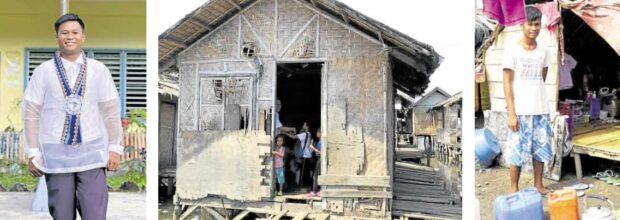
TRANSFORMATION Raymond Amil has gone a long way in the last nine years. From a skinny young man in 2014 (right), Amil is now an accomplished teacher assigned in an elementary school in Zamboanga City’s Pasilmanta Island. His journey as an educator started in this humble classroom in 2018 made of light materials which developed into what is now Bihing Tahik Elementary
School in Barangay Rio Hondo. —PHOTOS BY JULIE S. ALIPALA
ZAMBOANGA CITY—Ten years ago, Raymond Juldate Amil was struggling to piece together partially burned notes while reviewing for his Jan. 26, 2014, Licensure Examination for Teachers (LET).
Amil, now 33, was among the 120,000 residents displaced when Moro rebels lay siege to this city’s Barangay Rio Hondo in September 2013. All that he was able to salvage from the family home were his pieces of scribbled notes from his college days, a few personal belongings, and a partly burned banca (outrigger).
To be able to focus on the LET review, Amil struggled to put aside his fears and anxieties amid the constant pounding of bombs and escalating skirmishes between a band of Moro National Liberation Front fighters and government forces.
On March 7, 2014, Amil became one of the 11,120 examinees who passed the licensure exams for elementary school teachers. This gave some measure of hope for Amil and his family who were then making do with their cramped temporary shelter inside Don Joaquin F. Enriquez Memorial Sports Complex.
But hurdling the LET did not guarantee him a teaching position. No school was interested in hiring him because he was a Badjao.
“I submitted so many applications, I guess almost all the schools here in Zamboanga City, but no one was hiring me,” Amil told the Inquirer back in 2014.But this did not dampen Amil’s enthusiasm in becoming a teacher. Alkhodari Jakaria, the principal of Mariki Elementary School, took him in as a volunteer and was assigned to handle classes in designated temporary learning centers, for a monthly allowance of P500.
“He is a hardworking young teacher, he never complains,” Jakaria recalled in a recent interview.
He observed that Amil had the dedication to teaching young children, enthusiastically hopping from one transitory shelter site to another to hold classes among mostly members of the Badjao tribe.
MILESTONE Badjao and Sama preschool children pose with their parents just before the moving up ceremony in 2018 in what was then the Bihing Tahik Primary School. Going on to the next education ladder has been a life-changing journey for the Badjao and Sama families of Barangay Rio Hondo. —JULIE S. ALIPALA
READ: Cebu Institute of Medicine grad tops October 2023 Physician Licensure Examination
New home, learning center
By mid-2016, the displaced families began to resettle into permanent shelters set up by the government at Sitio Buggoc in Barangay Rio Hondo. This gave Amil the opportunity to establish an Alternative Learning System (ALS) site so the children can have a follow-through instruction from their days in the transitory shelter. More than a hundred Badjao families sent their children to the ALS.
After a series of visits by officials of the Department of Education (DepEd), Amil got a nod for transforming the center into a primary school, now known as Bihing Tahik (Seaside) Primary School (School ID No. 199008), mainly serving Badjao children.
It did not take long for the enrollment to swell to over 200.
Badjao parents like Napsa Jimlani, 50, a mother of 14, was proud to have six of her children in school there.
“Because of Mastal (Teacher) Amil, I will soon have high school children and all my children have birth certificates. He helped us in securing birth certificates so our children can go to school,” Jimlani said in the Sama Badjao dialect.
Amil, with the help of parents and soldiers, utilized rundown shelters in Sitio Buggoc for the children’s classrooms, aided by donations from the Land Transportation Office in the Zamboanga Peninsula.
Col. Rolly Gomez, former commander of the Army’s 11th Infantry Battalion, whose unit led the rehabilitation of dilapidated shelters to be used into classrooms, sees Amil’s determination as inspiring and infectious.
“We saw the determination of Teacher Ray to teach and help Badjao kids, and that inspired us to extend our hands to him so that he could be able to put up an area where he could teach the kids,” Gomez, now a defense attaché in India, said in an online interview.
Disability
At the height of the COVID-19 pandemic, Amil was reassigned to the city’s island-barangay Pasilmanta Island (formerly Sacol Island) to teach in the local elementary school. A new principal, Mina Shella Rosos, took over Bihing Tahik Primary School. By then, the school population had increased to over 400 and had opened its doors to non-Badjaos.
Amil goes to Pasilmanta every week, driving 25 kilometers by motorcycle from Rio Hondo to Sangali and then taking a pumpboat to Pasilmanta, sailing for at least 30 minutes.
In January last year, Amil lost his left leg in a vehicular accident; a truck hit him while on the road. On that same day, he also lost his father, Johnson, due to a lingering illness.
But not even the loss of his leg can stop him.
“It was an accident and no one was at fault. I lost a leg but life is good because I am still alive and can still teach,” Amil said in an interview.
The DepEd helped him secure a prosthetic leg.
“I am back to teaching on the island. It doesn’t matter if you can walk or not, what is important is we help educate young children. I used to have two avid learners, my mother and my father. My family is my inspiration to pursue education,” Amil said.